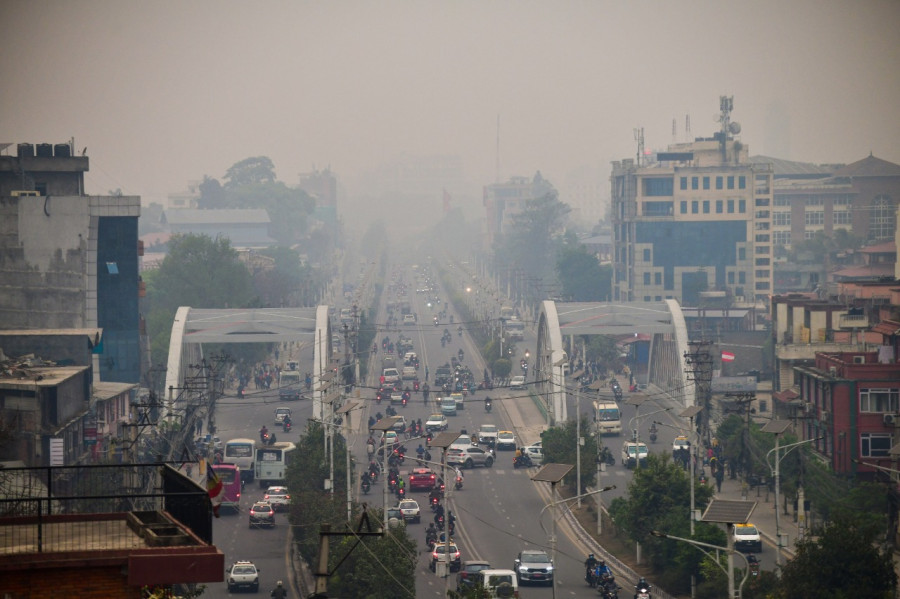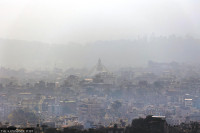Health
Deteriorating air quality amid spike in Covid-19 cases causes concerns
Experts say asking people to stay inside and wear face masks is just a temporary solution and stress a long-term plan to deal with such situations.
Arjun Poudel
For the last few days, Bir Hospital has been seeing a steady rise in the number of Covid-19 cases. The hospital that saw one or two cases earlier is receiving at least five patients a day lately, doctors say.
“We found that most of the infected people are seeking care after becoming serious,” Dr Ashesh Dhungana, a pulmonologist at the hospital, told the Post. “A majority of the patients are elderly with comorbidities. We have to admit most of these patients.”
The rise in infection numbers is a cause for concern, which has been exacerbated by the worsening air quality in Kathmandu Valley.
Kathmandu became the most polluted place in the world on Friday afternoon, with smoke and haze covering the Valley. The Valley’s air quality level reached hazardous levels on Saturday and Sunday as well.
Air pollution is known to cause various respiratory illnesses and since coronavirus primarily affects the lungs, health experts warn that worsening air quality could lead to an increase in hospitalisation cases and even deaths among the people infected with the coronavirus.
“It has been observed that the severity of coronavirus spread is high in densely populated cities like Kathmandu,” said Dr Dhungana of Bir Hospital. “From this, we could conjecture that poor quality may be one of the factors for high incidence of Covid-19.”
Even if there were no coronavirus infections, poor air quality can cause short- and long-term effects on public health. Bad air quality can cause pneumonia, bronchitis, conjunctivitis, skin allergy, stroke and heart problems, among others, in the short term and ulcers and cancer of the lungs and intestine, kidney disease and heart problems in the long run, doctors say.
Dr Raju Pangeni, senior consultant at the Department of Pulmonary and Critical Care at HAMS Hospital, says as the severity of Covid-19 is high among patients with comorbidities, the worsening air quality in Kathmandu Valley is not a good sign.
“New cases are rising and this time we are very much at risk,” said Pangeni. “Those residing in polluted cities are at high risk of getting serious and dying from the infection of coronavirus.”
Doctors say people above 55 years have a high chance of comorbidities and those having such underlying conditions are at risk of getting seriously ill and dying.
Although Nepal on Sunday recorded no deaths, there were three fatalities on Saturday from the coronavirus infection, pushing the death toll to 3,027. On Saturday 85 positive cases were recorded and on Sunday 89.
After seeing a steady decline in the coronavirus cases, with as little as 47 on March 6, the number of infections has gone up of late. Public health experts have sounded alarm also because India is reporting a surge in coronavirus cases.
Nepal became one of the first countries in the world to vaccinate its people when it launched its inoculation drive on January 27. After concluding the second phase on March 15, by then around 1.8 million people had been jabbed, the government has suspended the vaccination campaign for the lack of shots.
The government currently has around 500,000 doses, enough only to give booster shots to those 438,000 people who took their first jabs between January 27 and March 5.
Around 1.35 million people above 65 years of age were given the first shots in the second phase between March 7 and March 15. They need to be given their booster doses May 16 onwards.
With India putting a halt to exports of AstraZeneca vaccine, the one Nepal has been using, the government’s vaccination plan is currently in limbo.
Amid this, a surge in cases and sudden deterioration of air quality have made matters worse.
A study, published in Cardiovascular Research, a journal of European Society of Cardiology, estimated that about 15 percent of deaths worldwide from Covid-19 could be attributed to long-term exposure to air pollution.
Another new study by researchers at Harvard University has shown that people infected with Covid-19 who live in areas with high levels of air pollution are more likely to die from the illness than those who live in less polluted regions.
After the air quality of Kathmandu Valley reached hazardous levels, the Ministry of Health and Population has urged the general public to stay indoors and wear face masks if they need to go outside.
Public health experts say the deteriorating air quality in Kathmandu should serve as a wake-up call for the authorities. They say maintaining a healthy air quality is not just about limiting the risk of Covid-19 but about the overall health of the citizens.
Since Friday afternoon, Kathmandu’s air has remained among the most polluted in the world. While Kathmandu was ranked the most polluted city on Friday afternoon, it was the second most polluted city in the world on Sunday at 3:45 pm, with Air Quality Index (AQI) readings of 281, which is of ‘very unhealthy’ quality.
As per IQ Air, the Swiss Group that manages real-time worldwide air quality data, Kathmandu’s AQI level has remained between ‘very unhealthy’ to ‘hazardous’ levels in the last three days with the highest AQI level recorded at 411 at 9:45 am on Saturday with PM2.5 at 366 micrograms per cubic metre (μg/m3), the highest recorded too.
Very unhealthy quality of air means health warnings of emergency conditions and the entire population is more likely to be affected whereas hazardous level calls for health alert and everyone may experience more serious health effects.
“Authorities should focus on finding long term solutions to address the problem of air pollution,” said Dr Pangeni of HAMS Hospital.




 8.12°C Kathmandu
8.12°C Kathmandu













%20(1).jpg&w=300&height=200)
